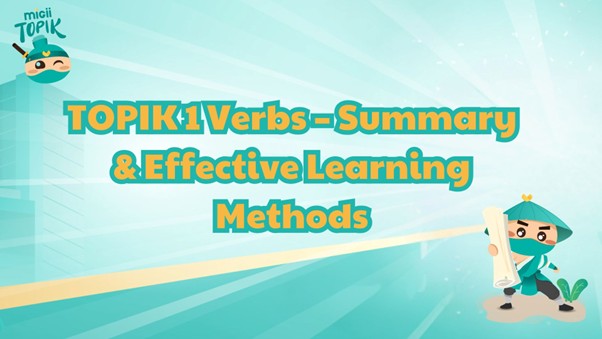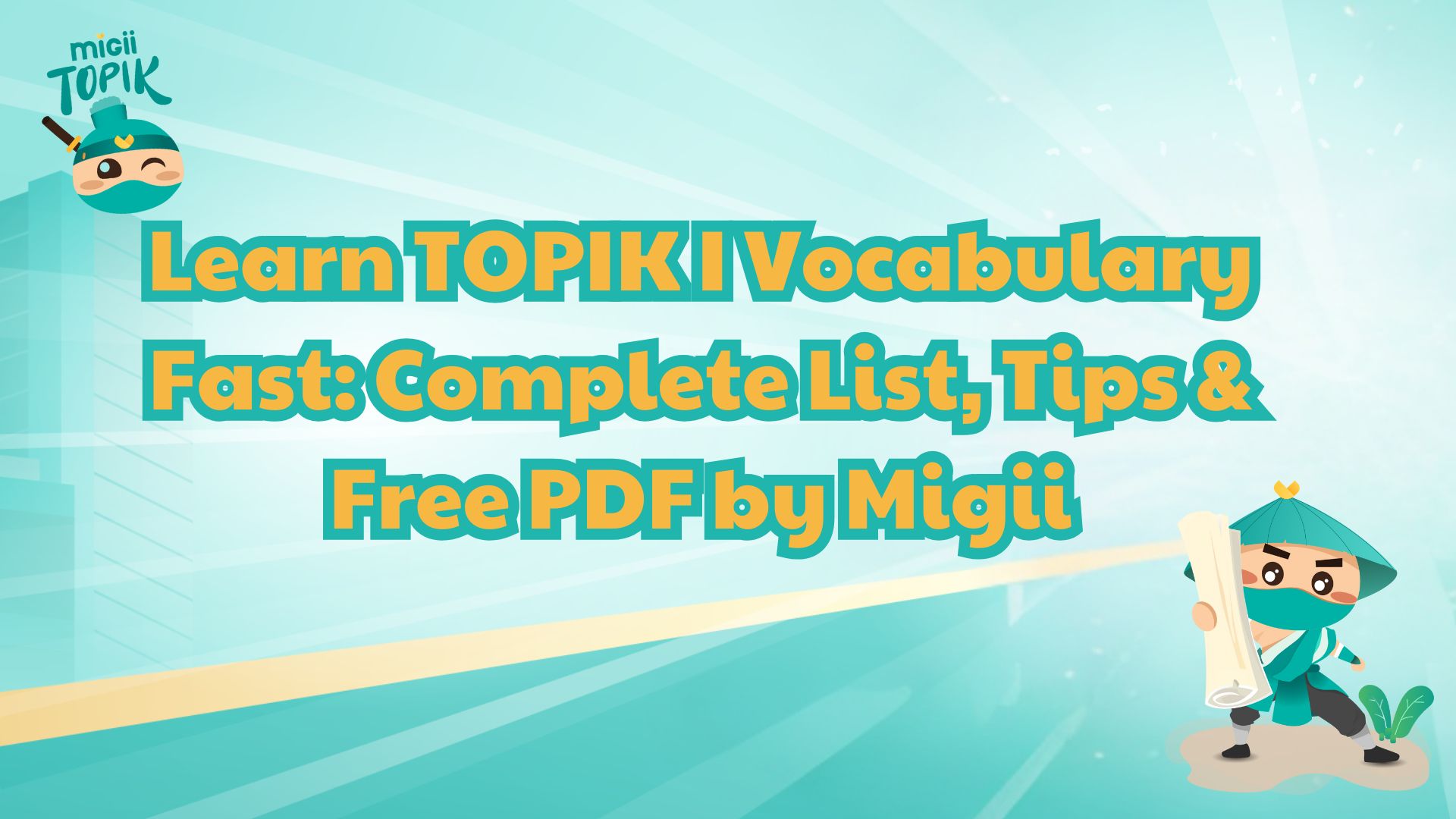TOPIK 3 Vocabulary or TOPIK Level 3 Vocabulary forms the foundation for learners stepping into the intermediate stage of Korean. At this level, you’ll need to master around 2,000–2,500 words, covering not only everyday topics but also more complex themes such as work, travel, emotions, and social relationships. Learning TOPIK 3 Vocabulary helps you not only pass the TOPIK exam more easily but also communicate, read, and write in Korean with greater confidence and fluency.
Introduction Topik 3
The TOPIK (Test of Proficiency in Korean) is an official Korean language proficiency test designed to assess the language ability of non-native speakers. Among its six levels, TOPIK Level 3 marks the transition from basic to intermediate proficiency, where learners are expected to understand and use Korean in everyday life, work, and social contexts.
At this stage, a strong command of vocabulary plays a crucial role in mastering all three sections of the test — reading, listening, and writing. Without sufficient word knowledge, even solid grammar skills cannot fully support comprehension or expression.
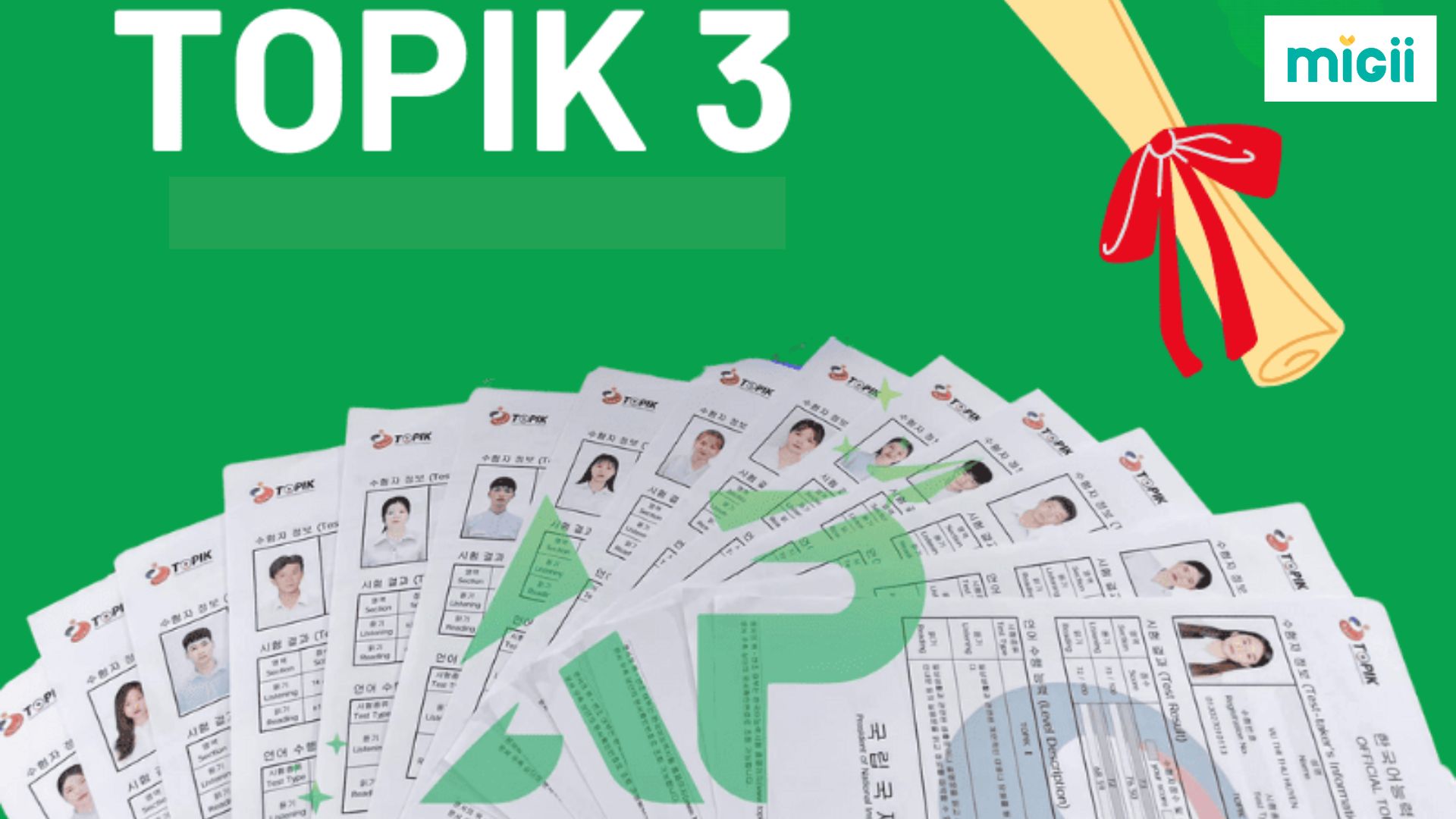
Introduction Topik 3
Therefore, building a solid foundation in TOPIK 3 vocabulary or TOPIK level 3 vocabulary is essential. It not only helps you pass the exam with confidence but also serves as a stepping stone toward becoming a fluent Korean communicator.
Characteristics of TOPIK 3 vocabulary
TOPIK 3 Vocabulary represents the intermediate level of Korean word usage, where learners begin to go beyond simple daily expressions. The vocabulary at this level expands to include words commonly used in academic, workplace, and social settings. Learners are expected not only to understand these words but also to apply them naturally in conversations, essays, and comprehension tasks.
Most of the vocabulary in this range consists of verbs, adjectives, abstract nouns, and basic idiomatic expressions. These word types appear frequently in reading passages and listening tasks, making them crucial for achieving a good score on the test.
Compared with TOPIK 2 vocabulary, the words at Level 3 often involve more nuance and context. For example, while Level 2 focuses on describing simple actions or feelings, Level 3 introduces vocabulary for expressing opinions, plans, and relationships in greater detail.
Learning the right vocabulary groups — organized by topic or word type — allows learners to study more efficiently. By focusing on high-frequency words that appear in past exams and real-life contexts, you can save time and retain vocabulary more effectively.
|
Feature |
TOPIK 2 Vocabulary |
TOPIK 3 Vocabulary |
|
Level |
Beginner to lower-intermediate |
Intermediate |
|
Word count |
~1,500 words |
~2,000–2,500 words |
|
Context |
Daily life (shopping, family, food, hobbies) |
Broader contexts (school, work, society, opinions) |
|
Word types |
Mainly simple nouns and verbs |
Verbs, adjectives, abstract nouns, idioms |
|
Grammar usage |
Short, basic sentences |
More complex sentence patterns and connectors |
|
Example words |
먹다 (to eat), 학교 (school), 예쁘다 (pretty) |
결정하다 (to decide), 경험 (experience), 사회 (society) |
|
Learning goal |
Communicate in basic daily situations |
Express ideas, give opinions, understand news and articles |
Mastering TOPIK 3 vocabulary builds the bridge from everyday Korean to more natural, contextual, and expressive language use — a vital step toward achieving higher fluency and success in the TOPIK exam.
Structure and vocabulary range in TOPIK 3
At the TOPIK Level 3, learners are expected to master approximately 2,400–3,000 words. This range covers both everyday vocabulary and more sophisticated terms used in social, cultural, and professional settings. The goal is not only to recognize these words but also to understand their nuances and apply them appropriately in various contexts.
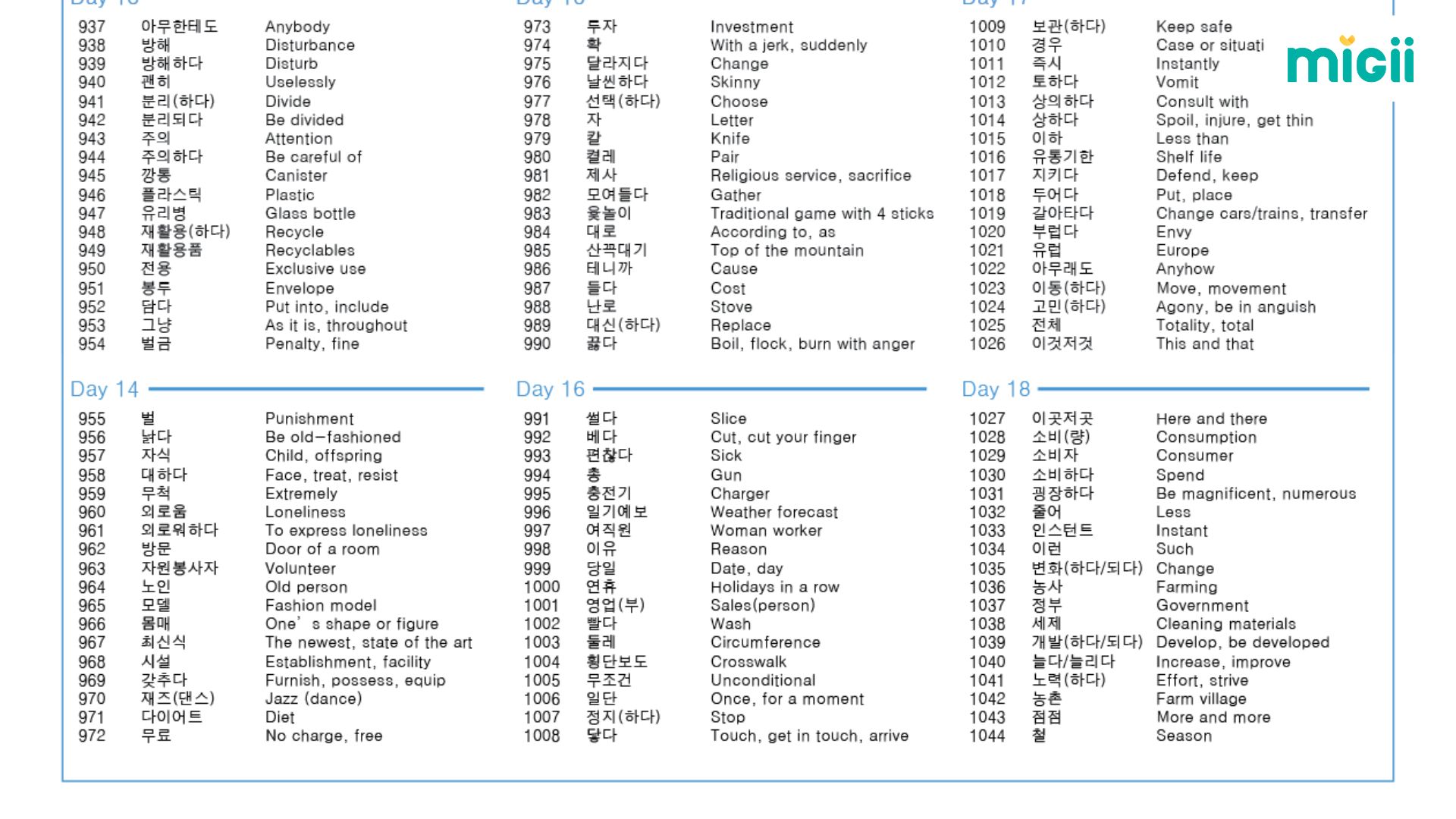
Structure and vocabulary range in TOPIK 3
- Daily Life – family, work, shopping, health, and leisure
- Korean Society and Culture – traditions, customs, and social norms
- Workplace Communication – meetings, teamwork, responsibilities
- Emotions and Opinions – expressing feelings, attitudes, and viewpoints
- Education and Learning – study habits, academic terms, future goals
Learning vocabulary by theme helps learners connect words with real-life situations, making them easier to remember and use naturally in both speech and writing.
|
Korean Word |
Meaning |
Example Sentence |
|
경험 |
experience |
새로운 경험을 통해 많은 것을 배웠어요. (I learned a lot through new experiences.) |
|
결정하다 |
to decide |
그는 유학을 가기로 결정했어요. (He decided to study abroad.) |
|
직장 |
workplace |
좋은 직장을 구하기가 쉽지 않아요. (It’s not easy to find a good job.) |
|
건강 |
health |
건강을 지키기 위해 운동을 해야 해요. (You should exercise to stay healthy.) |
|
의견 |
opinion |
제 의견을 말씀드리고 싶어요. (I’d like to share my opinion.) |
|
행복하다 |
to be happy |
가족과 함께 있을 때 가장 행복해요. (I’m happiest when I’m with my family.) |
|
문화 |
culture |
한국 문화를 배우는 것이 재미있어요. (It’s fun to learn about Korean culture.) |
|
변화 |
change |
세상은 빠르게 변화하고 있어요. (The world is changing quickly.) |
|
준비하다 |
to prepare |
발표를 잘하기 위해 열심히 준비했어요. (I prepared hard to give a good presentation.) |
|
도움 |
help, assistance |
친구의 도움이 정말 필요했어요. (I really needed my friend’s help.) |
Mastering these types of words within diverse themes ensures a well-rounded vocabulary base. It enables you to confidently handle TOPIK 3 reading passages, listening tasks, and writing prompts, moving you closer to true intermediate fluency in Korean.
Effective method to learn TOPIK 3 vocabulary
Learn by Topic: Group Vocabulary by Semantic Fields for Better Retention
One of the most effective ways to master TOPIK 3 vocabulary is to learn by topic — grouping words that share similar meanings or belong to the same context. This method helps your brain build stronger connections between related words, making it easier to recall and use them naturally in conversation or writing.
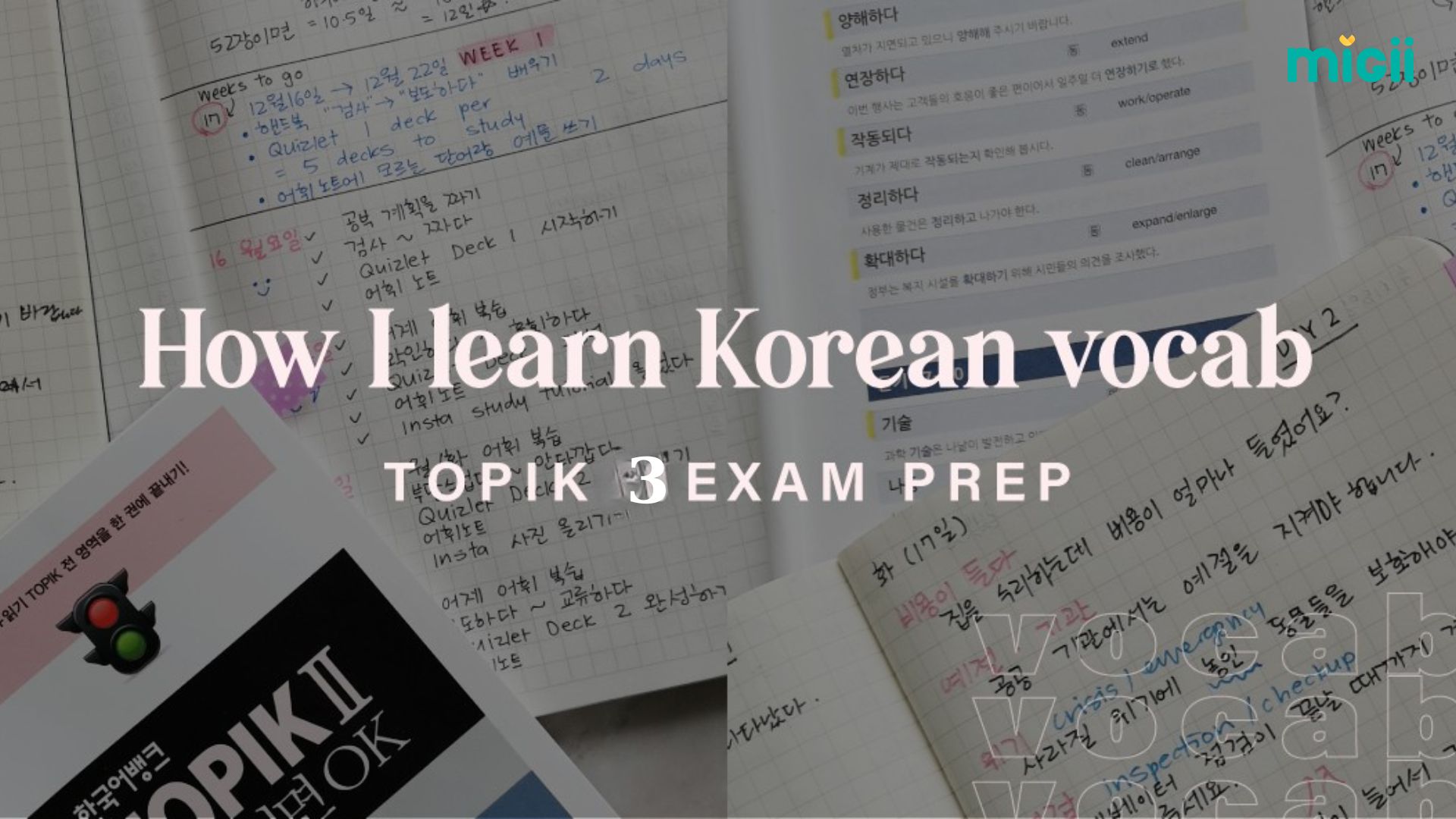
Effective method to learn TOPIK 3 vocabulary
For example, instead of memorizing random words, you can study vocabulary in clusters such as:
- Daily Life: 음식 (food), 시장 (market), 요리하다 (to cook), 가격 (price), 맛있다 (delicious)
- Emotions: 기쁘다 (happy), 슬프다 (sad), 화나다 (angry), 걱정하다 (to worry)
- Workplace: 회의 (meeting), 동료 (colleague), 보고서 (report), 준비하다 (to prepare)
- Health: 병원 (hospital), 아프다 (to be sick), 치료 (treatment), 건강 (health)
By focusing on thematic learning, you not only remember words longer but also understand how they function together in sentences — a key skill for achieving fluency and performing well in TOPIK Level 3 reading and writing sections.
To make your study more efficient, you can download a curated vocabulary list organized by topic and frequency of use:
Here are Topik 3 vocabulary download links:
This resource provides categorized word lists with English meanings and example sentences, helping you learn smarter and progress faster toward your TOPIK goals.
Learn Through Real Contexts: Using Flashcards, Apps, and Short Reading Practice
Memorizing TOPIK 3 vocabulary becomes far more effective when you learn words in real contexts rather than in isolation. By engaging with sentences, dialogues, and short readings, you can see how vocabulary naturally appears in conversation and writing — making it easier to recall and apply during the exam.
A few proven methods include:
- Flashcards: Create your own flashcards or use apps like Anki, Quizlet, or Memrise to review words through spaced repetition. Seeing words repeatedly in context strengthens long-term memory.
- Mobile Apps: Use Korean learning apps such as TOPIK One, Naver Dictionary, or LingQ, which provide example sentences, pronunciation, and audio for each word.
- Short Reading Practice: Read simple Korean articles, webtoons, or news summaries on platforms like Naver News Easy or TOPIK Guide. Highlight new words and note how they are used in different sentence structures.
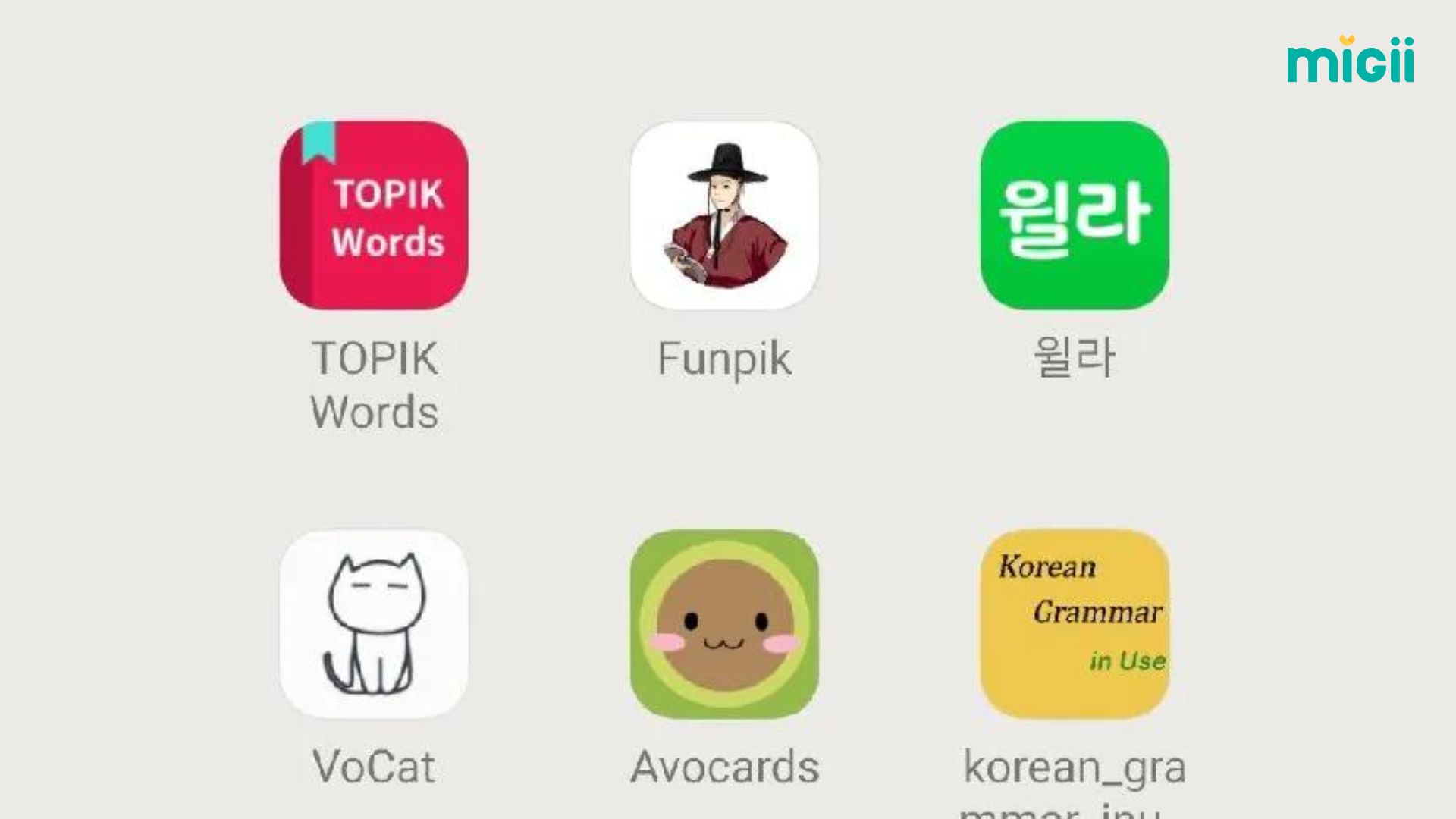
Topik 3 vocabulary learning app
When you learn vocabulary through real usage, each word carries meaning, emotion, and tone — not just a dictionary definition. This approach helps you internalize TOPIK Level 3 vocabulary naturally, improving your comprehension, speaking, and writing skills at the same time.
Remember Vocabulary Through Examples
The best way to truly remember TOPIK 3 vocabulary is by learning each word through examples in real sentences. When you connect a word with context, emotion, or a story, it becomes easier for your brain to store and recall it naturally. Instead of rote memorization, seeing how a word functions in sentences helps you understand its tone, collocations, and common usage patterns.
For instance:
|
Korean Word |
Meaning |
Example Sentence |
|
노력하다 |
to make an effort |
목표를 이루기 위해 열심히 노력하고 있어요. (I’m working hard to achieve my goal.) |
|
이유 |
reason |
늦은 이유를 설명해 주세요. (Please explain the reason for being late.) |
|
약속 |
appointment, promise |
내일 친구와 약속이 있어요. (I have an appointment with a friend tomorrow.) |
|
중요하다 |
to be important |
시간 관리가 정말 중요해요. (Time management is really important.) |
|
기억하다 |
to remember |
그날의 일을 아직도 기억하고 있어요. (I still remember what happened that day.) |
Try to create your own example sentences after learning new words — this personalizes the learning process and improves retention.
Practice Actively: Listen – Read – Write to Reinforce Vocabulary
To effectively retain and apply TOPIK 3 vocabulary, learners should adopt an active, multi-skill approach that integrates listening, reading, and writing. This method develops comprehension and usage simultaneously — crucial for success in all sections of the TOPIK exam.
1. Listening Practice
- Purpose: Reinforce pronunciation, rhythm, and contextual understanding.
- Method: Listen to Korean podcasts, news clips, or educational YouTube channels such as Talk To Me In Korean or KBS World Radio.
- Tip: Focus on recognizing vocabulary you’ve studied and note how it’s used in different tones and situations.
2. Reading Practice
- Purpose: Expand recognition and understand word usage in grammar and syntax.
- Method: Read short Korean articles, webtoons, or dialogues suitable for intermediate learners.
- Tip: Highlight unfamiliar words, write down their meanings, and review them weekly using word lists or flashcards.
3. Writing Practice
- Purpose: Transform passive knowledge into active use.
- Method: Write short paragraphs about your day, opinions, or summaries of what you read or listened to.
- Tip: Intentionally include new vocabulary in your writing to reinforce memory and fluency.
Example Integration Routine
|
Activity |
Duration |
Goal |
|
Listening to a short podcast |
15 mins |
Identify 5–10 familiar words |
|
Reading a short article |
20 mins |
Highlight and note 5 new words |
|
Writing a short summary |
15 mins |
Use at least 3 new words correctly |
Consistent repetition across these three skill areas ensures balanced language development and deeper word retention.
TOPIK 3 vocabulary practice book
To strengthen your TOPIK 3 vocabulary and improve overall test performance, using structured study materials is highly recommended. Below are two excellent books widely used by Korean learners preparing for the TOPIK exam:
Complete Guide to the TOPIK (New Edition)
A comprehensive preparation book covering all sections of the TOPIK exam — Listening, Reading, and Writing.
- Includes detailed vocabulary explanations, grammar notes, and mock tests.
- Suitable for learners from Level 2 to Level 4, especially those aiming to solidify intermediate vocabulary.
Here are Complete Guide to the TOPIK download links:
TOPIK Vocabulary in 40 Days for Beginners
A practical and well-structured vocabulary book designed to help learners build a strong foundation in Korean within 40 days.
- Divided into daily lessons, each focusing on essential vocabulary and expressions commonly used in the TOPIK Levels 1–3.
- Includes English and Chinese translations for every word, along with simple example sentences for better understanding.
- Ideal for self-learners who want a clear, step-by-step study plan to improve consistency and retention.
Download TOPIK Vocabulary in 40 Days for Beginners (PDF)
This book is perfect for learners who prefer short, focused daily study sessions. By completing all 40 lessons, you can confidently master the TOPIK 3 vocabulary base and smoothly transition to more advanced materials.
Quick memorization and review tips
To truly master TOPIK 3 vocabulary, learners should combine consistent memorization, review, and practical usage. Learning vocabulary is not just about rote memorization — it’s about systematic repetition and connecting words with real-life contexts. Below are some practical tips to help you build lasting study habits and improve retention:
Quick & Effective Learning Tips:
- Spend 15–20 minutes daily reviewing with flashcards — this helps your brain retain words through active recall.
- Study 30 words per day by specific themes (e.g., emotions, workplace, shopping) to strengthen word associations within the same topic.
- Use online quizzes or TOPIK 3 vocabulary apps such as Quizlet, TOPIK Guide, Memrise to test and reinforce your vocabulary.
- Write short Korean diaries every day to naturally apply and remember new words.
Consistent review and active usage of new words in speaking or writing will help you not only “memorize” but also understand deeply and use correctly in any context.
Conclusion
Mastering TOPIK 3 vocabulary is an essential step toward achieving the intermediate level (TOPIK 4). To learn effectively, combine smart strategies like studying by topic, using spaced repetition, and taking regular practice tests. Consistency is the key — just 20–30 minutes of focused study each day can make a big difference. You can also enhance your progress with learning platforms like Migii, which provide structured word lists, quizzes, and exercises designed specifically for TOPIK 3 learners.

